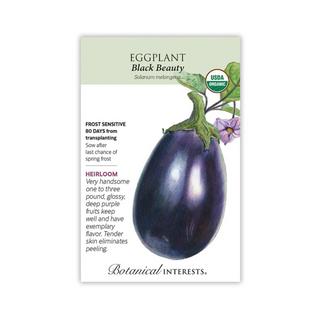
Description
A beautiful vegetable with lovely, lavender blossoms pretty enough to grow in the flower garden. 'Black Beauty' has set the standard since 1902 for large, high-quality fruit. Outstanding when harvested at their peak, the skin is tender, so no need to peel it. A widely used international food; there are countless recipes from Italy to China to Russia and beyond.
Variety Info
- Days to Maturity: 80 days from transplanting
- Family: Solanaceae
- Native: Asia
- Hardiness: Perennial in tropical climates; grown as annual in climates other than those that are frost-free and very warm; very frost sensitive.
- Exposure: Full sun
- Plant Dimensions: 24"–30" tall and wide
- Variety Info: 5"–6 ½" oblong, 1–3 lb. fruit with smooth, glossy purplish-black skin, off-white to tan interior. In the late 1800s, the 'Black Pekin' Chinese eggplant was crossed with 'Large Early Purple', creating 'Imperial Black Beauty', also known as 'Black Beauty', the largest eggplant grown.
- Attributes: Frost Sensitive
Sowing Info
- When to Sow Outside: 2 to 4 weeks after your average last frost date, when soil temperature is at least 70°F, ideally 80°–90°F, and when outside night air temperature is above 60°F.
- When to Start Inside: RECOMMENDED. 10 to 12 weeks before your average last frost date. Transplant outdoors 1 to 2 weeks after last frost, when soil temperature is at least 60°F, and outside night air temperature is above 60°F.
- Days to Emerge: 10–20 days
- Seed Depth: ¼"
- Seed Spacing: Start indoors
- Row Spacing: 36"
- Thinning: Start indoors; plant 18" apart outside
Growing Info
- Harvesting: Black Beauty' should be harvested when the fruit is 5"–6 ½" long and the skin is still shiny. If you are in doubt about maturity level, note that it's better to harvest eggplants a little young rather than wait until they are overly mature with dull skin, eventually possibly turning a golden color, with a lot of seeds, and bitter taste. To harvest, cut the stem with pruners. Frequent harvesting will encourage more production and the largest fruit.
Description
A beautiful vegetable with lovely, lavender blossoms pretty enough to grow in the flower garden. 'Black Beauty' has set the standard since 1902 for large, high-quality fruit. Outstanding when harvested at their peak, the skin is tender, so no need to peel it. A widely used international food; there are countless recipes from Italy to China to Russia and beyond.
Variety Info
- Days to Maturity: 80 days from transplanting
- Family: Solanaceae
- Native: Asia
- Hardiness: Perennial in tropical climates; grown as annual in climates other than those that are frost-free and very warm; very frost sensitive.
- Exposure: Full sun
- Plant Dimensions: 24"–30" tall and wide
- Variety Info: 5"–6 ½" oblong, 1–3 lb. fruit with smooth, glossy purplish-black skin, off-white to tan interior. In the late 1800s, the 'Black Pekin' Chinese eggplant was crossed with 'Large Early Purple', creating 'Imperial Black Beauty', also known as 'Black Beauty', the largest eggplant grown.
- Attributes: Frost Sensitive
Sowing Info
- When to Sow Outside: 2 to 4 weeks after your average last frost date, when soil temperature is at least 70°F, ideally 80°–90°F, and when outside night air temperature is above 60°F.
- When to Start Inside: RECOMMENDED. 10 to 12 weeks before your average last frost date. Transplant outdoors 1 to 2 weeks after last frost, when soil temperature is at least 60°F, and outside night air temperature is above 60°F.
- Days to Emerge: 10–20 days
- Seed Depth: ¼"
- Seed Spacing: Start indoors
- Row Spacing: 36"
- Thinning: Start indoors; plant 18" apart outside
Growing Info
- Harvesting: Black Beauty' should be harvested when the fruit is 5"–6 ½" long and the skin is still shiny. If you are in doubt about maturity level, note that it's better to harvest eggplants a little young rather than wait until they are overly mature with dull skin, eventually possibly turning a golden color, with a lot of seeds, and bitter taste. To harvest, cut the stem with pruners. Frequent harvesting will encourage more production and the largest fruit.

